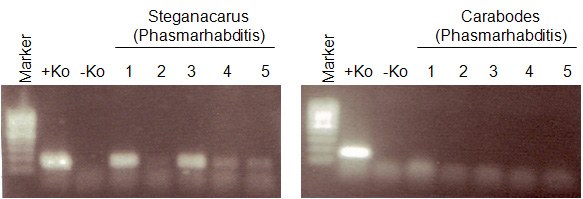The nematode based food-chain of a temperate deciduous forest
The project is funded by the DFG and run in cooperation with Dr. Mark Maraun.
Recent analyses of the natural variation of stable isotope data of soil microarthropods indicate that several species are not decomposers but belong to higher trophic levels. High 15N signatures indicate that they are either predators or scavengers, probably feeding on nematodes. The aim of the present study is to investigate if oribatid mites and Collembolan feed on nematodes under natural field conditions. Species-specific molecular markers (from the COI region; ~ 200 bp) are established for nematodes. These will be applied to detect potential nematode prey via gut content analysis of soil microarthropods.

Figs: Ethidium-stained agarose gel showing PCR products from nematode
specific primer pairs for the 154 bp fragment of the COI region.
Molecular techniques are used to investigate how long nematode prey can be detected in the gut of microarthropods in laboratory experiments. Soil microarthropod species from the field are tested for nematode prey. Overall this will contribute to the understanding of the nematode-based food-chain of temperate deciduous forests.